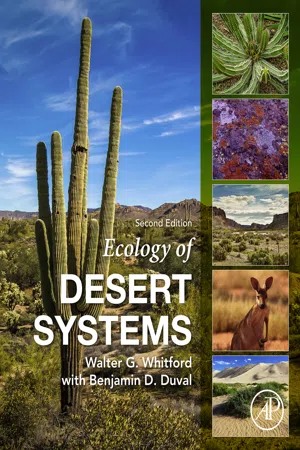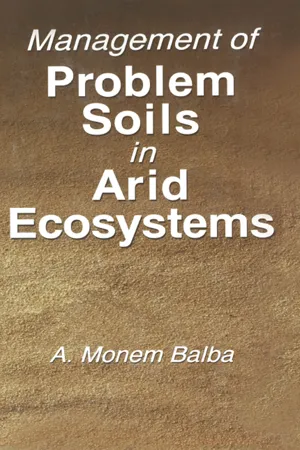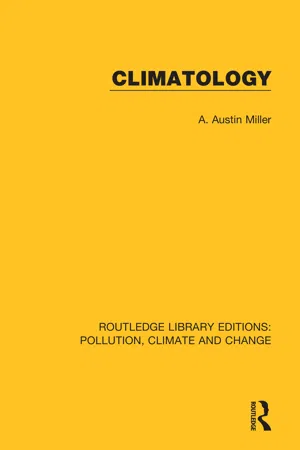Hot Deserts
Hot deserts are arid regions characterized by extreme temperatures, low precipitation, and sparse vegetation. They are typically found in subtropical regions and experience high daytime temperatures and significant temperature fluctuations between day and night. Hot deserts are home to specialized plant and animal species adapted to survive in harsh, dry conditions.
7 Key excerpts on "Hot Deserts"
- eBook - ePub
Warfare in a Fragile World
Military Impact on the Human Environment
- Sipri(Author)
- 2021(Publication Date)
- Routledge(Publisher)
...Some deserts, such as the Sahara or the Kalahari of southern Africa, are hot all the year round. Others, such as the Gobi of north-central China or the Great Basin Desert of western USA, are seasonally hot and cold. High daytime temperatures in the desert—which in some deserts can readily reach 40°C to 50°C in the shade—often alternate with rather cool (near freezing) night-time temperatures. Deserts are also often windy, especially in daytime and especially in the summer; dust storms or sandstorms are thus a recurring phenomenon. The desert regions of the world, as defined in this work, contain (on the basis of national reports to FAO) modest amounts of forest, presumably scrubby woodland (200 million hectares); some grassland, much of it actually desert or semi-desert used as extensive range land (900 million hectares); and a small amount of agricultural land (100 million hectares), some portion of which is irrigated. These desert regions also include, of course, built-up environments, comprising cities, transportation systems, military bases, and so forth (table 1.6). The global extent of the desert vegetation type sensu stricto is of the order of 1 800 million hectares. Plant and animal life does flourish locally in desert regions where water is supplied. Such oases are produced naturally by springs and exotic streams (i.e., those originating outside the region), of which some—the so-called arroyos or wadis —are intermittent. Conversely, there are desert regions which are totally barren. In the Sahara, for example, roughly 15 per cent of the overall area comes under the oasis category, 70 per cent is very sparsely vegetated, and the remaining 15 per cent is without vegetation. Desert fauna are mostly small, burrowing, and nocturnal. It cannot be over-emphasized that all the desert biota—plant and animal—depend upon the spatial and temporal distribution of water on the one hand, and upon the efficiency with which they capture and retain that water on the other...
- eBook - ePub
Exploring Environmental Issues
An Integrated Approach
- David D. Kemp(Author)
- 2004(Publication Date)
- Routledge(Publisher)
...Elsewhere, deserts are created by the rain shadow effects of mountain systems that lie across the prevailing wind directions — as in North America, where the Mojave and Sonoran Deserts owe their aridity to the presence of the Sierra Nevada blocking the moist air masses from the Pacific Ocean. The rain shadow effect also applies to the Gobi and other deserts in Central Asia. The Himalayas prevent the moisture from the Indian monsoon from reaching the area, but the continentality of the region is also an important element. Its distance from the ocean means that the air masses reaching the area have Figure 3.18 Temperature/precipitation graph for a tropical desert biome — Khartoum, Sudan lost most of their moisture before they arrive. The world's deserts cover some 5 million km 2, and an additional 40 million km 2 are arid or semi-arid. In total, almost 33 per cent of the earth's land surface exhibits desert characteristics to some degree or other. Limited precipitation and high evapotranspiration rates restrict plant growth, and the desert biome is distinguished by sparse vegetation cover, or, in some areas by the complete absence of plant life. Its overall biomass productivity is low. In places the high evaporation rates create very salty soils, which also inhibit plant growth. However, even these surfaces that appear completely devoid of vegetation may bloom immediately following precipitation, as seeds and dormant plants respond rapidly to the availability of moisture. Although the plant community in the desert is sparse it includes a variety of species, including grasses, shrubs such as sage and acacia as well as a mixture of cacti and other succulents that are particularly suited to cope with the lack of moisture. These plants are xerophytes, and are able to survive in the desert because they have adapted to the conditions (Stiling 1992)...
- eBook - ePub
- Walter G. Whitford, Benjamin D. Duval(Authors)
- 2019(Publication Date)
- Academic Press(Publisher)
...The high temperatures in most deserts are much higher than dew point temperatures. 10. In addition to the effects of global warming on dryland ecosystems, the tropics are expanding and pushing the arid zones toward the poles in both hemispheres. References Agam N., Berliner P.R. Dew formation and water vapor adsorption in semi-arid environments—a review. J. Arid Environ. 2006;65:572–590. Allen T.F.J., Starr T.B. Hierarchy: Perspectives for Ecological Complexity. Chicago: University of Chicago Press; 1982. Attum O., Kramer A., Baha El Din S.M. Thermal utility of desert vegetation for the Egyptian tortoise and its conservation implications. J. Arid Environ. 2013;96:73–79. Bates J.D., Svejcar T., Miller R.F., Angell R.A. The effects of precipitation timing on sagebrush steppe vegetation. J. Arid Environ. 2006;64:670–697. Beatley J.C. Phenological events and their environmental triggers in Mojave Desert ecosystems. Ecology. 1974;55:856–863. Beatley J.C. Climates and vegetation pattern across the Mojave/Great Basin Desert transition of southern Nevada. Am. Mid. Nat. 1975;93:53–70. Berndtsson R. Spatial and temporal variability of rainfall and potential evaporation in Tunisia. In: The Influence of Climate Change and Climatic Variability on the Hydrologic Regime and Water Resources. Proceedings of the Vancouver Symposium. IAHS Publication Number 168; 1987. Berndtsson B., Niemczynowicz J. Spatial and temporal characteristics of high-intensive rainfall in northern Tunisia. J. Hydrol. 1986;87:285–298. Bolin S.B., Ward T.J. An analysis of runoff and sediment yield from natural rainfall plots in the Chihuahuan Desert. In: USDA Forest Service. Strategies for Classification and Management of Native Vegetation for Food Production in Arid Zones. Rocky Mountain Forest and Range Experiment Station; 1987:196–200 General Technical Report RM-150. Bowers M.A. Precipitation and the relative abundances of desert winter annuals: a 6-year study in the northern Mohave Desert. J...
- eBook - ePub
- A. Monem Balba(Author)
- 2018(Publication Date)
- CRC Press(Publisher)
...The area of Lake Chad was much larger than it is now, thousands of years in the past. The Rajastan Desert was some 1500 km east of the arid region 8000 yr before. Generally, the borders of the arid regions are subject to short period changes depending on rainfall fluctuation. These climatic changes are shown geographically by expanding or shrinking the arid areas resulting in the change of semiarid regions to arid or subhumid regions (UNCOD Secretariat 57 ; Goudie 58). Table 1. Distribution of salt-affected areas in developing countries (areas in 1000 ha). 1 Country Area Mexico and Central America Cuba 316 Mexico 1649 1965 South America Argentina 85612 Bolivia 5949 Brazil 4503 Chile 8642 Colombia 907 Ecuador 387 Paraguay 21902 Peru 21 Venezuela 1240 129163 Africa Afras & Issas Territory 1741 Algeria 3150 Angola 526 Botswana 5679 Chad 8267 Cameroon 671 Egypt 7360 Ethiopia 11033 Gambia 150 Ghana 318 Guinea 525 Guinea. Bissau 194 Kenya 4858 Liberia 406 Libya 2457 Madagascar 1324 Mali 2770 Mauritania 640 Morocco 1148 Namibia 2313 Niger 1489 Nigeria 6502 Rhodesia 26 Senegal 756 Sierra Leone 307 Somalia 5602 Sudan 4874 Tanzania 3537 Tunisia 990 Zaire 53 Zambia 863 80529 Southeast Asia Indonesia 13213 Cambodia 1291 Malaysia 3040 Sarawak 1538 Thailand 1456 Vietnam 983 21521 South and West. Asia Afghanistan 3101 Bangladesh 3017 Burma 634 India 23796 Iran 27085 Iraq 6726 Israel 28 Jordan 180 Kuwait 209 Muscat and Oman 290 Pakistan 10456 Qatar 225 Saudi Arabia 6002 Sri Lanka 200 Syria 532 United Arab Emirates 1089 83570 Source : Massoud. 18 The desert environment is characterized with: a) high thermal stress on the inhabitants as high ambient air temperature in summer coupled with high intensity of solar radiation results in appreciable heat stress. b) The energy inflow from the sun into the arid zones is very high and much of it penetrates to the ground surface due to clear skies prevailing most of the year...
- eBook - ePub
- A. Austin Miller(Author)
- 2019(Publication Date)
- Routledge(Publisher)
...High atmospheric pressure is a condition unfavourable for precipitation; regions of seasonal high pressure suffer from seasonal drought (e.g. the winter drought of continental interiors), the permanent areas of high pressure will normally be areas of permanent drought. But it must not be supposed that the converse is true and that deserts are necessarily always areas of high pressure; in fact it often happens that the desert gives rise by excessive convection to intense low pressures, as, for example, in Sind in July and in Northern Australia in January (see pp. 151 and 160). The greatest deserts in the world occur beneath the ‘horse latitude’ highs: the Sahara, Arabia, Australia, Kalahari, Atacama. These are the great trade-wind deserts, covering an enormous space of the earth’s surface and doomed to backwardness on account of their aridity. Because of the difficulties of crossing them they present one of the most significant barriers of race, creed and civilization to be found on the earth. Because of their unproductiveness and the harshness of the environment they must be inhabited by nomadic peoples of great independence and strength of character, self-reliant, proud and lawless. The desert is the stronghold of Mohammedanism, the simple, rigid and severe creed of a monotonous and stern environment. Types of Desert. Deserts in all latitudes are united by their aridity, but they must be divided by their temperature. As far as summer temperature is concerned there is little difference between them despite differences of latitude. Luktchun (July 90°) is as hot as most places in the Sahara though 20° farther north, and the highest figure recorded here (118°) compares not unfavourably with Saharan stations. Some of the highest temperatures in the world are recorded in Death Valley (Gal.) in 36°N., and therefore well outside the tropics...
- Enrique Campos-Lopez(Author)
- 2019(Publication Date)
- Routledge(Publisher)
...The steppes of the Indian subcontinent are hot with mild to warm winter temperatures and summer precipitation. The steppes of central and eastern Asia (Figure 2) generally have cold and often severe winters. Summer temperatures however are usually warm. The steppes of Australia mild winters and warm summers In this region summers become (Figure 3) generally have except in the northern part, hot. The northern steppe areas in South America (Figure 4) have mild winters and warm summers. In the south winters become cool to cold, but the summers remain warm. Rainfall generally occurs in summer. The Brazilian steppe locally called caatinga has mild to warm winters, warm summers and summer rainfall, all being conditions favoring aridity. FIGURE 1. Arid lands of Africa (after Meigs) FIGURE 2. Arid lands of Asia (after Meigs) FIGURE 3. Arid lands of Australia (after Meigs) FIGURE 4. Arid lands of South America (after Meigs) The steppes of North America (Figure 5) exhibit a variety of climates. These range from cold winters and a short growing season in the north to warm steppes with mild winters and warm summers in the south. Improvement Versus Deterioration of Steppes A major reason for the identification and description of arid regions is to provide a basis for improvement, especially where deterioration has occurred. Desertification has been the catch word of the seventies, but I have mixed feelings about the use of the term. First I am not sure it expresses accurately what is happening. It might be more accurate to start with humid climates and note that through deterioration, sub-humidification takes place; in the subhumid region, there is semi-aridification; and in the semiarid region there would be true desertification, to be followed by hyper-desertification and that would be the end. While it is possible for complete desertification to occur in the sub-humid regions, even there it is by stages rather than happening in one step...
- eBook - ePub
The Global Casino
An Introduction to Environmental Issues
- Nick Middleton(Author)
- 2018(Publication Date)
- Routledge(Publisher)
...There are certain similarities with savannas in terms of fauna and the occurrence of fire, but unlike savannas, trees are absent in temperate grasslands. The vegetation is dominated by herbaceous (i.e. not woody) plants, of which the most abundant are grasses. The climate in this biome is temperate, seasonal and dry. Typical soils tend to be deep and rich in organic matter. Figure 1.3 An area of primary tropical rain forest, an evergreen biome with great biodiversity, in Panama, Central America. In many parts of the world, where climates become drier, temperate grasslands fade into the desert biome. Hyper-arid desert supports very little plant life and is characterized by bare rock or sand dunes, but some species of flora and fauna are adapted to the high and variable temperatures – the diurnal temperature range is typically high in deserts – and the general lack of moisture. Some water is usually available via precipitation in one of its forms: most commonly rainfall or dew, but fog is important in some coastal deserts (Figure 1.5). Sporadic, sometimes intense, rain promotes rapid growth of annual plants and animals such as locusts, which otherwise lie dormant for several years as seeds or eggs. A very distinctive form of vegetation is commonly associated with Mediterranean climates in which summers are hot and dry and winters are cool and moist. It is found around much of the Mediterranean Basin (where it is known as maquis), in California (chaparral), southern Australia (mallee), Chile (mattöral) and South Africa (fynbos). Low evergreen trees (forming woodland) and shrubs (forming scrub) have thick bark and small, hard leaves that make them tolerant to the stresses of climatic extremes and soils that are often low in nutrients. During the arid summer period this biome is frequently exposed to fire, which is important to its development and regeneration. All these natural biomes have been affected to a greater or lesser extent by human action...






